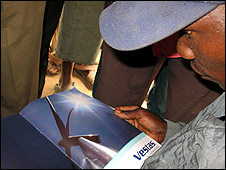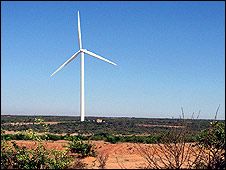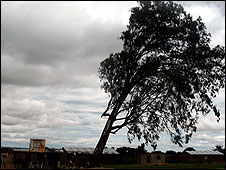Geza Ulole
JF-Expert Member
- Oct 31, 2009
- 59,185
- 79,366
Wind of change blows in Tanzania
By Daniel Dickinson
BBC News, Singida, central Tanzania

 They have seen the future - but will it work?
They have seen the future - but will it work?
A group of villagers gather at the local bicycle repair shop at Njiapanda, a dusty roadside hamlet on the rift valley in Singida region in central Tanzania, to marvel at magazine pictures of massive electricity-generating wind turbines. They have never seen anything like this before and are clearly impressed.
They will soon find out exactly what the turbines are like. In a matter of months, 24 of these 100m-plus-high power generators will be erected next to their homes, as part of the first commercial wind farm in sub-Saharan Africa.
This is one of the poorest parts of Tanzania. There is little agriculture, no industry, but one thing there is plenty of is wind.
It is an untapped resource, but one which could hold the key to providing much-needed electricity to central and northern Tanzania and kick-starting the development of the region.

 The people of Singida are expecting a lot of this project
The people of Singida are expecting a lot of this project

Regional Commissioner Parseko Kone
The 24 turbines, which should be in operation within 18 months, will generate 50 megawatts (MW) of power, almost 10% of Tanzania's current power needs.
The company behind the $113m project is Wind East Africa. "It's important that Tanzania diversifies its power sources," says project manager Mike Case.
"The country is very reliant on hydro-electric power, which means in times of drought, there is a power deficit. Oil-generated power is very expensive, so wind power offers a cheaper and more reliable alternative."
Fewer blackouts
The demand for power in Tanzania is growing by more than 50 MW a year, fuelled partly by an expansion of gold and nickel mining in the north of the country.
At present, electricity is sourced from power plants more than 1000km away. The wind farm at Njiapanda will mean that power-hungry industries will soon be provided with electricity generated locally.
 Electricity bills are unlikely to be reduced
Electricity bills are unlikely to be reduced
The wind farm will benefit the local economy, providing jobs during the construction phase and a handful of jobs when it is up and running.
Regional Commissioner Parseko Kone is also hoping the rest of his impoverished region will profit.
"The people of Singida are expecting a lot of this project," he says.
"They're hoping it will help to develop our economy and because wind is free, they're also expecting cheaper electricity tariffs."
It is unlikely that tariffs will come down, as electricity is already heavily subsidised, but it does mean that Tanzanians can expect fewer power blackouts.
Power play
Wind power on a commercial scale is unknown in sub-Saharan Africa, despite the existence of constantly blowing and consistently strong winds, especially along the top of the rift valley, the mountain plateau which runs through East Africa from Ethiopia to Malawi and Mozambique.
In Europe, the industry is well developed. Germany, the European leader in terms of generation, produces more than three gigawatts of power (3000 MW) from wind turbines. The target in many European countries is to have 50% of all power generated by wind.
 Wind is plentiful but under-exploited in central Tanzania
Wind is plentiful but under-exploited in central Tanzania
Africa is now set to benefit from the progress made in Europe. The equipment is becoming cheaper, as well as more robust.
According to wind expert Dr Ladislaus Lwambuka, from the University of Dar es Salaam, Africa is now ready for wind power on a commercial scale.
"If the Wind East Africa project is a success, then it could lead to more wind farms, not just in Tanzania but in the rest of Africa, particularly along the rift valley, where we know the winds are strong."
There are already plans, if the first phase of the project goes well, to double the number of wind turbines and increase Wind East Africa's output to up to 100 MW.
The people of Njiapanda and the surrounding dusty plateau may not know it now, but this small part of the rift valley will, by then, be the epicentre of wind power in sub-Saharan Africa.
BBC NEWS | Business | Wind of change blows in Tanzania
Any idea if this project is existing?
By Daniel Dickinson
BBC News, Singida, central Tanzania


A group of villagers gather at the local bicycle repair shop at Njiapanda, a dusty roadside hamlet on the rift valley in Singida region in central Tanzania, to marvel at magazine pictures of massive electricity-generating wind turbines. They have never seen anything like this before and are clearly impressed.
They will soon find out exactly what the turbines are like. In a matter of months, 24 of these 100m-plus-high power generators will be erected next to their homes, as part of the first commercial wind farm in sub-Saharan Africa.
This is one of the poorest parts of Tanzania. There is little agriculture, no industry, but one thing there is plenty of is wind.
It is an untapped resource, but one which could hold the key to providing much-needed electricity to central and northern Tanzania and kick-starting the development of the region.



Regional Commissioner Parseko Kone
The 24 turbines, which should be in operation within 18 months, will generate 50 megawatts (MW) of power, almost 10% of Tanzania's current power needs.
The company behind the $113m project is Wind East Africa. "It's important that Tanzania diversifies its power sources," says project manager Mike Case.
"The country is very reliant on hydro-electric power, which means in times of drought, there is a power deficit. Oil-generated power is very expensive, so wind power offers a cheaper and more reliable alternative."
Fewer blackouts
The demand for power in Tanzania is growing by more than 50 MW a year, fuelled partly by an expansion of gold and nickel mining in the north of the country.
At present, electricity is sourced from power plants more than 1000km away. The wind farm at Njiapanda will mean that power-hungry industries will soon be provided with electricity generated locally.

The wind farm will benefit the local economy, providing jobs during the construction phase and a handful of jobs when it is up and running.
Regional Commissioner Parseko Kone is also hoping the rest of his impoverished region will profit.
"The people of Singida are expecting a lot of this project," he says.
"They're hoping it will help to develop our economy and because wind is free, they're also expecting cheaper electricity tariffs."
It is unlikely that tariffs will come down, as electricity is already heavily subsidised, but it does mean that Tanzanians can expect fewer power blackouts.
Power play
Wind power on a commercial scale is unknown in sub-Saharan Africa, despite the existence of constantly blowing and consistently strong winds, especially along the top of the rift valley, the mountain plateau which runs through East Africa from Ethiopia to Malawi and Mozambique.
In Europe, the industry is well developed. Germany, the European leader in terms of generation, produces more than three gigawatts of power (3000 MW) from wind turbines. The target in many European countries is to have 50% of all power generated by wind.

Africa is now set to benefit from the progress made in Europe. The equipment is becoming cheaper, as well as more robust.
According to wind expert Dr Ladislaus Lwambuka, from the University of Dar es Salaam, Africa is now ready for wind power on a commercial scale.
"If the Wind East Africa project is a success, then it could lead to more wind farms, not just in Tanzania but in the rest of Africa, particularly along the rift valley, where we know the winds are strong."
There are already plans, if the first phase of the project goes well, to double the number of wind turbines and increase Wind East Africa's output to up to 100 MW.
The people of Njiapanda and the surrounding dusty plateau may not know it now, but this small part of the rift valley will, by then, be the epicentre of wind power in sub-Saharan Africa.
BBC NEWS | Business | Wind of change blows in Tanzania
Any idea if this project is existing?